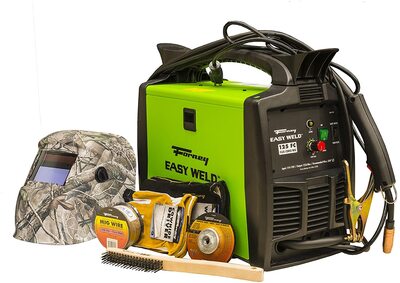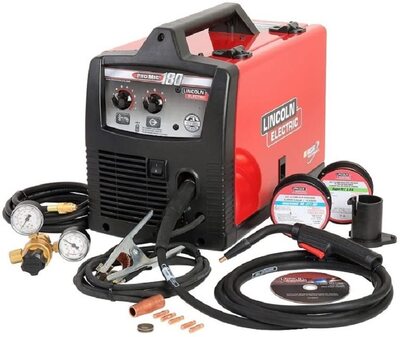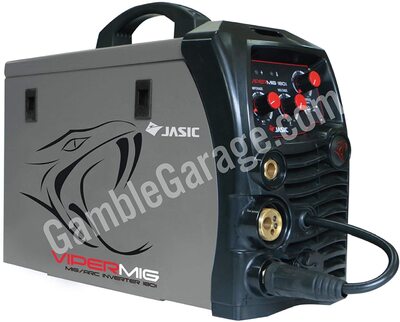MIG welding is a unique process that can help you with securing many different surfaces. You can weld items like steel and aluminum with ease. The support included through a MIG welder can help you with getting many surfaces prepared accordingly while being easy to maintain. But to make a MIG welder work, you have to look at how well such a unit is operated. This guide will help you look at various MIG welders that are easy to manage in many forms.
Contents
Top 3 110V MIG Welder Reviews in 2023
Product | |||
Brand | Forney Industries | Hobart | LOTOS |
Dimensions | 24.5 x 24.5 x 25 inches | 19 x 11 x 13 inches | 22 x 10 x 16 inches |
Item Weight | 57 pounds | 57 pounds | 54 Pounds |
Special Features | Best MIG Welder for Beginner | Best Budget MIG welder | Best MIG Welder for Home Use |
Best 110V MIG Welders
1. Forney Easy Weld 29901 – Best MIG Welder for Beginner
You can use this Forney welder for handling many of your power needs. The design offers a simple arrangement for ensuring the power you use is handled evenly without being hard to adjust.
The Forney welder works with a 110V power source that is appropriate for all basic needs, although this is also flexible for use with 120V materials for your convenience. The design works well without having to get any gas in some cases, although a gas source is recommended for ensuring the surface works right.
The unit includes separate switches for sheet metal and thin plate materials. These help with producing enough power in the unit to keep the setup from warping any metals you are trying to add material onto.
The heating stick used in this setup is easy to weld and provides a smooth layout so long as the surface is used accordingly.
The wire feed knob includes a firm design that is easy to handle and organize. The design includes a convenient organization that is not hard to utilize.
Pros
Cons
2. Hobart 500559 Handler 140 MIG Welder – Best Budget MIG welder
Hobart makes this welder a choice that offers help for many surfaces and for producing a more efficient and secure weld every time, thus producing a more efficient and suitable body for work.
The 110V unit works with up to 115V of power to help you move the welding material at the speed that you see fit. The unit works with a stable arc at all thickness levels. The five-position voltage control feature also adds a smooth surface to anything you want to weld with.
This works with up to 24-gauge materials on quarter-inch mild steel. You can use this with brass, titanium, copper, and cast iron among an assortment of surfaces.
The five-position voltage control setup works for producing a better arc for many welding needs. A 200 amp work clamp is also added for producing extra energy for the most intense heating and welding needs you might have when trying to get a secure body ready for your welding needs.
Pros
Cons
3. Lotos MIG140 – Best MIG Welder for Home Use
The flexible design of the Lotos MIG140 works for most of the heating needs that you might have. The unit operates with a gentle approach for handling heat without being hard to apply.
The unit works with many types of wires, including flux-cored wires that are suitable for thicker metal needs. The aluminum wire feeder is stable and adds a smooth layout for handling metal.
The transformer included in this design can link up to a 110V wall outlet in moments. You can get the entire unit set up in about ten minutes on average.
The switches include a 2T/4T operation lever. This switches between two and four-touch functions. The 2T setup lets you press and hold a torch to weld, while the 4T layout is a latching mode that lets you press a surface to start and then another to stop. You can use the latter for larger tasks, while the 2T option is best for when you have a smaller amount of materials to work with at a time.
Pros
Cons
Best 220V MIG Welders
4. Everlast PowerMIG 200 – Best MIG Welder for Heavy Duty Task
The 220V welders can be utilized for heavy-duty tasks, although you might find that some models can work in both 110 and 220V setups. This Everlast model is one such choice, although the 200 amps of power produced should provide enough energy for even the toughe3st welding jobs you need to complete.
The IGBT inverter produces a stable arc performance that does not cause lots of splattering all around, thus improving upon how well the setup in the design works. The arc characteristics in the setup can be adjusted as required through the panel. The wire speed may be adjusted on the base, although the fastest speeds work best when you are using a more powerful wire surface and you need extra help with keeping the setup you use organized well.
A MIG gun can be added to the end for aluminum-based applications. The automatic flow feature also helps you to link the wire into the gun so you will have an open surface for application needs right away, especially when you demand that surface to work for you.
Pros
Cons
5. Goplus MMA TIG ARC IGBT Welding Machine – Best 220v MIG Welder
The lightweight design of this Goplus model is useful, but this unit is made mainly with basic and lighter welding solutions in mind. The Goplus unit can provide you with a slim design for welding that works in a few minutes for smaller wires. This is not intended for large-scale tasks, but it is useful for touch-ups and for when you need to work on the most intricate and lightest of tasks in space.
The nylon panel is helpful for keeping the motor inside the machine stable. But the voltage protection feature is an even more important point. The voltage is monitored regularly to ensure the machine will produce the right amount of heat without being hard to generate or use.
The compact body works mainly with aluminum wires, although you can use some copper and stainless steel materials if needed. The unit will also link up to most gas tanks for producing the power and support needed for getting the welding project one wants to handle managed right.
Pros
Cons
6. Lincoln Electric PRO-MIG 180 – Best MIG Welder for Home Workshop
You can get many tasks under control with this welder that operates a simple interface without being a challenge to use. The PRO-MIG 180 welder from Lincoln uses a sturdy wire and an adjustable drive system that keeps tangling issues and crushing from developing when used right. The welder keeps the connection you use under control while being easy to support.
A brass-to-brass gun link is included to produce a better sense of conductivity. The smooth arc also works with less splatter to keep the setup from being too hard to operate with. You can use this feature quite well for generating a better sense of temperature control.
The arc allows for a margin of error to produce a better grip. The aluminum gearbox also ensures the unit operates quietly while still producing the torque needed for the task at hand.
You can also utilize a diverse array of wires for the task at hand. These include wires up to .045 in diameter for most of your heating needs.
Pros
Cons
7. Razorweld ViperMig 180 Amp – Best MIG Welder Under 1000$
The last choice to see is this Razorweld model. The unit works with a design that offers help for many voltage levels. The nine-inch MIG gun offers a comfortable unit that is easy to work with. The ground unit also helps you with keeping the setup from being too hard to use or adjust as you see fit. The best part of using this is that the amp will help you with producing a better weld with a cast-iron surface that does not require too much pressure or effort on your part.
Multiple knobs are used for adjusting the MIG welder setup. These work for adjusting the amperage and voltage that you will require for getting the welder ready in any situation. The best part of using the model is that this offers a comfortable organization without rough surfaces. The 30-percent duty cycle also ensures the unit can work with many wire speeds as you see fit. This should be enough to help you to get more out of the power generation process.
Pros
Cons
Buying Guide For Best MIG Welders
What Is MIG Welding?
Metal Inert Gas or MIG welding works with a feeding spool that continuously moves along a surface A MIG welder uses a welding wire that moves along to burn and melt base and parent materials at a time. The MIG welder can work with various types of metals, including aluminum, stainless steel, and some lighter steel surfaces. You can also work with different types of steel thicknesses that suit your needs.
MIG welding is similar to tungsten inert gas or TIG welding based on how the organization works. But TIG is made with thin-gauge materials. MIG welding works better with different types of surfaces, including both thin and thick materials. The MIG process also makes it easy for you to handle different types of surfaces with a little extra room for error or adjustment. The process is not far too delicate, and yet the layout is effective and easy to handle if you know what you will get out of the materials you will utilize here.
The welding process works with a basic solid electrode with gas that comes from an outside source. Electrical power is applied to melt down the electrode and to get the material added into a weld joint. You will have to control how a torch is positioned and how you will move from one surface to the next during the welding process, but that is the only real manual control you have to utilize when getting the process to work.
What Gases Are Used?
Argon is used as the most prominent gas for moving the materials out in the MIG welding process. Helium may also be added to increase the fluidity of the weld pool. Oxygen and carbon dioxide are also incorporated in many applications to stabilize the space that is being treated. Also, hydrogen can work for some cases, although the material works best for stainless steel surfaces.
Beneficial Points of MIG Welding
The process is very productive and does not cost to utilize. You can work with many metals and alloys while working in many positions.
The electrode is continuously fed to your welder, thus preventing false starts and stops from developing. You do not have to worry about too many extensive cleaning processes either, what with there being a lack of a covering slag on the head of the welder.
Concerns Surrounding MIG Welding
The equipment needed for MIG welding can be tough to tote around on occasion. Also, the welding torch is flammable and should be held accordingly to ensure the material will not get into any unwanted surfaces or possibly produce any fires. The radiated heat produced by the welder may also become uncomfortable and hard to handle in some situations.
The base metal for the welding should be clean and safe to use. A rust-free surface must also be utilized to ensure space is not going to wear out or be too hard to manage in any situation.
Types of MIG Welding
1. Short Circuit Transfer
A short circuit transfer process for MIG welding works with a welding wire that will touch the metal. The welding wire is melted and will move to the metal surface to create a pool that establishes a joint between two pieces.
You can use carbon dioxide gas for this transfer option. The voltage should also be minimal enough to where the process is relatively safe. Some shielding gas is needed to make the process work.
2. Globular Transfer
A globular transfer process uses a higher voltage plus an argon gas. The wire will melt and is collected at the tip of your welding gun. The wire then drips down onto the joint a few times in a second. This is a useful process that adds extra control over how the material is spread out, but this may also cause some splatter effects to develop in the spot you are trying to add materials in.
3. Spray Transfer
A spray transfer process works with a series of small droplets that will be spread onto the joints in a mist-like array. The process generates a hissing sound and creates a better amount of coverage all around the surface when applied well enough.
4. Pulsed Spray Transfer
The fourth MIG welding option entails a pulsed spray transfer routine. This is for low-voltage situations, particularly 110V setups. The pulsed voltage ensures that the transfer mixes between spray and globular forms. You do not require an extensive amount of voltage to make this choice work for you, although the welds generated might be a little tough to handle if you are not careful enough.
Factors to Consider When Finding the Right MIG Welder
1. The setup process
Take a look at how the setup for your MIG welder is organized. The welder needs to come with a sturdy continuous wire and a feed unit for keeping that wire intact. The MIG gun should be planned right with an arc for administering the wire at the end. A gas cylinder also has to link up to the welding unit. Don’t forget about the power supply. You should find 110V and 220V models in most cases for your convenience.
2. Wire support
The welder needs to be capable of supporting a firm and sturdy wire. A smaller machine can use a 0.23-inch wire for basic securing needs. A 0.3-inch wire is also suitable for any sheet metal surface. You can also find some 0.35 and 0.45-inch wire surfaces for helping you produce a good design.
3. Gas support
See how well the gas in your welder is laid out and that the unit can handle the proper amount of gas flow required for a secure setup. The gas control feature should help you with keeping the welding materials moving around your surface.
4. Electrode stick out
A short electrode stick out will produce a hotter weld. This might be effective for some heating plans, although you have to watch for the quality of the weld based on what you plan on adding so you have a bit of extra control over how heat is to be applied.
5. Interface
The interface for the welding unit should come with an easy-to-review design. Knobs for adjusting how powerful the welding process will be should be reviewed to see if the setup works evenly.
6. Assistance with many welding functions
You also have to look at how well different welding functions may be supported in your welding unit. The setup should be reviewed based on how quickly you can get the welder to move along a surface without threatening any other materials. Look at how well the design is arranged so you have more control over the design you wish to use.
Editor’s Pick
Based on our expert reviews, the best option for a MIG welder that you can use is the Forney Easy Weld unit. The assorted input and output options and the simplified interface can also help you with producing the heat that you need for many tasks that you wish to work with.
A Final Note
Based on our reviews, the best option for a MIG welder that you can use is the Forney Easy Weld unit. The welder provides you with a firm body for handling many welding needs. The best part of using the welder is that it offers help for many wires and spools. The assorted input and output options and the simplified interface can also help you with producing the heat that you need for many tasks that you wish to work with.
The MIG gun on this Forney welder uses a simple interface for your convenience. The arrangement gives you more help for various welding needs so you will not struggle with trying to make the heating arrangement work to your liking for all the requirements you might have.
All of the MIG welders you can use in this guide are suitable for many functions and tasks at hand. But you must also see how well such a welder can work in general and that you have an idea of how well the welding process is to work and that you recognize how well you can get such a unit to be ready for all the welding demands you might have.






